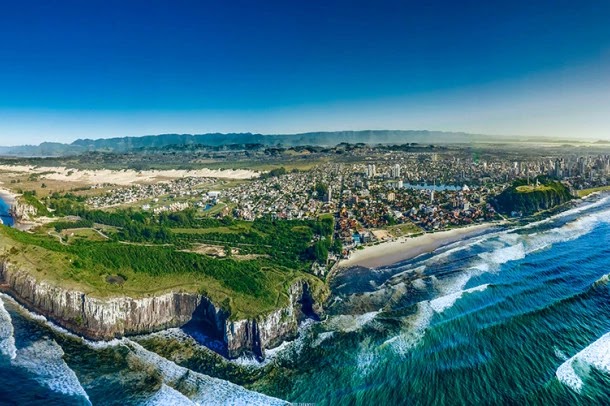The
Executive Board of UNESCO has accepted the designation of eight additional
UNESCO Global Geoparks, raising the total number of sites in the Global
Geoparks Network to 177 across 46 countries. This year, two additional nations,
Luxembourg and Sweden, joined the Global Network by establishing their first
geoparks.
The
UNESCO Global Geopark title acknowledges internationally significant geological
assets. In 2015, member states overwhelmingly authorized its establishment. The
geological diversity of the sites in this network underlies the ecological and
cultural diversity of diverse areas. Local communities benefit from geoparks
because they combine conservation of their unique geological heritage with
public outreach and sustainable development.
With
these eight additional designations, the Network now spans a total surface area
of 370,662 km2, about equivalent to Japan's size.
Ø Here are the
newly designated UNESCO Global Geoparks
1 1.
Seridó UNESCO Global Geopark, Brazil
The Seridó
UNESCO Global Geopark covers an area of 2,800 km² in the semi-arid northeast of
Brazil. It is home to more than 120,000 inhabitants, including communities like
the Quilombolas, who keep alive the memory of their enslaved ancestors from
Africa to preserve their culture through traditional practices, mus The Seridó
UNESCO Global Geopark covers an area of 2,800 km² in the semi-arid northeast of
Brazil. It is home to more than 120,000 inhabitants, including communities like
the Quilombolas, who keep alive the memory of their enslaved ancestors from
Africa to preserve their culture through traditional practices, museums and
cultural centres. eums and cultural centres.
The
geopark has one of South America's greatest scheelite mineralizations, an
important tungsten resource, as well as basalt flows resulting from volcanic
activity during the Mesozoic and Cenozoic Eras. This geodiversity is
responsible for a substantial part of the region's distinctive biodiversity,
which is typified by the Caatinga (Tupi meaning "white woodland"), an
ecoregion with distinct subtropical flora. The Caatinga is the world's only
entirely Brazilian biome, which implies that much of its biological history is
unique to Brazil.
2. 2
Southern Canyons Pathways UNESCO Global Geopark, Brazil
The UNESCO Global Geopark Caminhos dos Cânions do Sul in southern Brazil
spans 2,830.8 km2 and is home to 74,120 people. It is characterized by Atlantic
Forests, which are one of the most biodiverse ecosystems on the globe. The
pre-Colombian inhabitants of the region used to hide in paleoburrows
(underground cavities created by extinct paleo-vertebrate megafauna such as the
gigantic ground sloth), several of which can still be seen in the geopark. The
location also has some of South America's most stunning canyons, which were
produced by the continent's unique geomorphological processes after the split
of the Gondwana supercontinent 180 million years ago.
3 3.
Salpausselkä UNESCO Global Geopark, Finland
Home to around 177,000 inhabitants, the Salpausselkä
UNESCO Global Geopark is located in southern Finland, in the southernmost part
of the Finnish Lakeland, covering an area of 4,506 km². Around 21% of the
geopark is covered by water and over half by forests. The hundreds of lakes in
the geopark are a central feature of the landscape, along with the long,
distinct Salpausselkä ridges. Extending over more than 600 km across southern
Finland, the ridges consist of sediments deposited by glaciers.
They bear witness to climate change, specifically to
the the Younger Dryas, the cool period that lasted roughly from 12,900 to
11,600 years ago, and disrupted the Northern Hemisphere’s warming trend at the
end of the Pleistocene Epoch (2.6 million to 11,700 years ago).
Studied since the 19th century, these
ridges constitute Finland’s best-known geological heritage set in a landscape
formed by melting glaciers that created glaciofluvial landforms and rock
formations that store an abundance of groundwater and provide the region with
naturally high-quality drinking water.
4 4. Ries UNESCO Global Geopark, Germany
The Ries
UNESCO Global Geopark is mostly in Bavaria, with a tiny portion in Baden-Würtemberg,
and includes the Ries Crater, which is located between the Swabian and
Franconian Alb in southern Germany. The geopark has a total size of 1,749 km2
and a population of roughly 162,500 people.
A
meteorite crashed with Earth at this location around 15 million years ago,
leaving an impact crater that is the best-preserved meteorite crater in Europe
and the most carefully researched impact structure among the almost 200 known
craters worldwide.
On their
own or on guided excursions, visitors may explore the Nördlinger Ries impact
crater and learn about its geology and history by hiking along nature paths
that lead to spectacular viewpoints.
Information
centres and school programmes are also available. The geopark provides an
intriguing insight into the Earth’s history through its unique natural
landscape, cultural and culinary history.
5. 5 Kefalonia-Ithaca UNESCO Global Geopark, Greece
The UNESCO
Global Geopark of Kefalonia – Ithaca is a Heptanese island group in Western
Greece (from the Greek for seven, the number of principal Ionic islands).
Kefalonia has a population of 35,801 people living on 773 km2, whereas Ithaca
has a population of 3,084 people living on 117 km2. The geopark is rich in
karstic geosites like as caves, sinkholes, and subterranean streams, which are
distributed throughout the islands and tell of a geological history dating back
over 250 million years. Both islands are near to the Hellenic arc, an
arc-shaped mountain range produced by the sinking of the African Plate beneath
the Eurasian Plate. It is Europe's most tectonically active area.
The geopark
is also home to prehistoric Hellenistic and Roman monuments, medieval castles,
Byzantine and post-Byzantine monasteries, traditional settlements, windmills,
bridges and lighthouses, a rich cultural heritage scattered over the area’s
extraordinary geological features.
6.
Mëllerdall UNESCO
Global Geopark, Luxembourg
The
rural Mllerdall UNESCO Global Geopark in eastern Luxembourg comprises 256 km2
and has a population of roughly 25,500 people. The geopark is located in the
Trier-Luxembourg Basin, which stretches from the Paris Basin to the Rhenish
Massif. It contains the Luxembourg Sandstone Formation, which may be up to 100
meters thick and comes from the Lower Liassic period (205 to 180 million years
ago). It is one of Western Europe's most magnificent sandstone landscapes and
has been a tourist destination since the late 1800s. Today, visitors may
explore the region by following a dense network of well-signposted hiking
routes, including the 112-kilometer Mullerthal Trail, which was named Leading
Quality Trails – Best of Europe.
7.
Buzău Land UNESCO Global Geopark, Romania
The steep and rocky terrain of the Buzău Land UNESCO Global Geopark, located in Romania's Carpathian Bend Area, comprises 1,036 km2 and is home to 45,000 people. Several tectonic plates clashed in the area, forming a complicated fold and thrust mountain range that was subsequently worn by glaciers.
The geopark
showcases 40 million years of geological history and is one of Europe's most
geodynamically active places. Ectonic motions drove mountains up throughout
this time, transforming a deep-sea environment into a terrestrial one. The
Carpathians feature well-preserved fossils of marine animals, terrestrial
plants, mammals, and birds from the last glacial. Amber, a petrified resin,
preserves many fossils of beetles, spiders, crabs, reptiles, and other animals.
Some
of the longest and deepest salt caves in the world are also found here,
remnants of large deposits of salt and gypsum formed by the evaporation of
shallow enclosed bodies of water. This rich geodiversity has influenced a
unique cultural heritage with local legends in which mud volcanoes become
dragons, mud boilers are traps made by giants to catch cattle, and the future
can be predicted by looking through a lens of amber.
8.
Platåbergens UNESCO Global Geopark, Sweden
The Platbergens UNESCO Global Geopark in West Sweden encompasses 3,690 km2 and has a population of 289,198 people. It has a one-of-a-kind panorama of 15 flat-topped Table Mountains, known as platbergen in Swedish. Erosion sculpted these mountains 115,000 years ago during the last Ice Age.
The Västgöta Plain,
with its shallow floodplain lakes, undulating hills, and well-preserved
cultural landscapes, is also included in the region. From megalithic graves
(5,300-4,700 BCE) to the first known stone church in Sweden, built by Christian
Vikings in the early 11th century, some of Sweden's most interesting historical
discoveries have been made in this area, where museums preserve numerous
vestiges that bear witness to residents' use of the local stone over millennia.
Two
of the newly designated UNESCO Global Geoparks are situated in Latin America
and six in Europe. Owing to COVID-19 restrictions, no new applications from
Asia, Africa or the Arab region could be evaluated this year but several
projects for the creation of new geoparks on these parts of the world are under
way.






















0 Comments